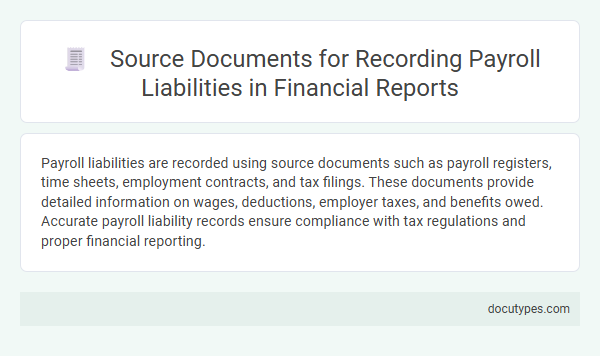Payroll liabilities are recorded using source documents such as payroll registers, time sheets, employment contracts, and tax filings. These documents provide detailed information on wages, deductions, employer taxes, and benefits owed. Accurate payroll liability records ensure compliance with tax regulations and proper financial reporting.
Introduction to Payroll Liabilities
Payroll liabilities represent the amounts a business owes to employees and government agencies related to employee compensation. Understanding the source documents for recording these liabilities is essential for accurate financial reporting and compliance. You must gather and review key documents such as payroll registers, tax forms, and wage statements to ensure proper recording of payroll obligations.
Importance of Source Documents in Payroll Reporting
| Source Document | Description | Role in Recording Payroll Liabilities | Importance in Payroll Reporting |
|---|---|---|---|
| Employee Time Sheets | Records of hours worked by employees during a pay period. | Provide accurate data for calculating gross wages and hours to be compensated. | Ensure precise payroll liability calculations and prevent overpayment or underpayment. |
| Payroll Register | Detailed summary of all employee earnings, deductions, and net pay. | Serves as the primary reference for payroll expenses and deductions liabilities. | Supports accurate financial reporting and audit trail maintenance for payroll transactions. |
| Tax Withholding Statements (e.g., Form W-4) | Employee forms indicating tax withholding allowances and exemptions. | Determine correct federal and state tax liabilities to be deducted from employees' pay. | Helps organizations comply with tax regulations and avoid penalties. |
| Benefit Enrollment Forms | Documents detailing employee-selected benefits and contributions. | Record obligations for deductions and employer payroll liabilities related to benefits. | Ensures accurate tracking of benefits-related liabilities in payroll reporting. |
| Direct Deposit Authorizations | Employee consent forms for electronic payment of wages. | Facilitate timely and accurate payroll distribution, supporting liability recognition upon payment. | Enhances efficiency and accuracy in payroll disbursement and reporting. |
| Payroll Tax Returns (e.g., Form 941) | Government forms reporting payroll taxes withheld and paid by the employer. | Document employer tax liabilities for federal, state, and local payroll taxes. | Critical for compliance and verifying accuracy of recorded payroll liabilities. |
Types of Payroll Source Documents
What are the types of payroll source documents used for recording payroll liabilities? Payroll source documents include time cards, payroll registers, and employee earnings records. These documents provide essential details needed to accurately calculate and record payroll liabilities in your accounting system.
Payroll Register and Its Role
Payroll registers serve as primary source documents for recording payroll liabilities, detailing employee earnings, deductions, and employer contributions. These records provide comprehensive data required for accurate liability calculation and ensure compliance with tax regulations. You rely on payroll registers to verify and document all payroll-related financial obligations systematically.
Time Sheets and Attendance Records
Time sheets and attendance records are essential source documents for accurately recording payroll liabilities. These documents provide detailed information on employee hours worked, ensuring correct calculation of wages and related liabilities.
- Time Sheets - Record the number of hours worked by each employee during a specific pay period.
- Attendance Records - Track employee presence, absences, and leave to verify payable hours.
- Payroll Accuracy - Both documents serve as primary evidence for calculating gross pay and deductions accurately.
Pay Slips and Employee Earnings Statements
Pay slips and employee earnings statements serve as primary source documents for recording payroll liabilities in accounting. These documents provide detailed information on wages, deductions, and employer contributions necessary for accurate financial records.
- Pay Slips - Pay slips itemize an employee's gross pay, tax withholdings, and net pay for each pay period, facilitating precise payroll liability tracking.
- Employee Earnings Statements - Earnings statements summarize cumulative wages and deductions over a specific period, supporting verification of payroll totals and liabilities.
- Use in Payroll Accounting - Both documents validate payroll expenses and liabilities for tax reporting, compliance, and financial audits.
Accurate management of pay slips and earnings statements ensures reliable recording and reporting of payroll liabilities.
Tax Withholding Forms (W-4, W-9, etc.)
Source documents for recording payroll liabilities are essential for accurate tax and wage reporting. Tax withholding forms such as W-4 and W-9 provide critical information for calculating employee tax obligations.
- Form W-4 - Details employee's federal income tax withholding preferences to ensure correct payroll deductions.
- Form W-9 - Collects taxpayer identification information for contractors and freelancers, aiding proper reporting and tax withholding.
- Payroll Registers - Summarize wages, tax withholdings, and deductions, supporting accurate recording of liabilities.
Government Remittance Documents
Government remittance documents serve as essential source documents for recording payroll liabilities. These documents provide detailed records of the amounts withheld and owed to various government agencies.
Common examples include tax forms such as the IRS Form 941 for federal tax deposits and state-specific remittance reports. Accurate recording of these documents ensures compliance with payroll tax regulations and proper liability tracking.
Documentation for Employee Benefits and Deductions
Payroll liabilities arise from obligations to pay employee wages, benefits, and various deductions. Accurate source documents are essential to ensure proper recording of these liabilities in financial records.
Documentation for employee benefits and deductions includes benefit enrollment forms, authorization letters for voluntary deductions, and official government withholding notices. These records verify the amounts withheld for health insurance, retirement contributions, taxes, and garnishments. Maintaining organized and complete source documents supports compliance and accurate payroll liability reporting.
What Are the Source Documents for Recording Payroll Liabilities? Infographic

